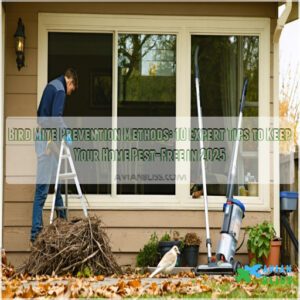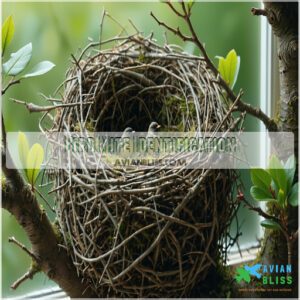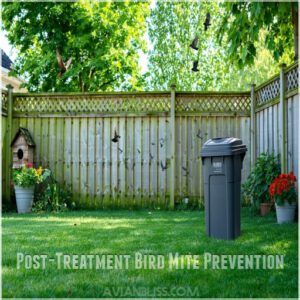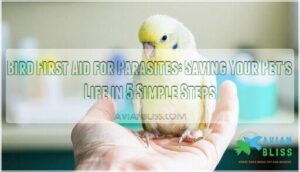This site is supported by our readers. We may earn a commission, at no cost to you, if you purchase through links.

Regular cleaning is key—vacuum carpets, wash bedding, and wipe surfaces often. Use diatomaceous earth in crawl spaces or near entry points as a natural barrier.
If mites are persistent, consider insecticides with permethrin or deltamethrin for targeted control. Trim shrubs and trees touching your home to reduce nesting areas.
Table Of Contents
- Key Takeaways
- Bird Mite Identification
- Preventing Bird Mite Infestation
- Bird Mite Control Methods
- Treating Bird Mite Bites
- Post-Treatment Bird Mite Prevention
- Frequently Asked Questions (FAQs)
- How do pest control services treat bird mites?
- Is there a natural remedy for ear mites?
- How do you treat a bird mite bite?
- How to get rid of bird mites in Your House?
- What temperature kills Bird mites?
- What is heat treatment & cold treatment for bird mites?
- What keeps bird mites away?
- What do mites hate the most?
- What is a natural repellent for bird mites?
- How to control mite infestation?
- Conclusion
Key Takeaways
- Seal entry points like cracks, gaps, and vents to stop mites from sneaking inside.
- Remove nearby bird nests promptly and clean the area with proper safety gear to eliminate breeding grounds.
- Vacuum daily with a HEPA filter and wash fabrics in hot water to kill mites and eggs.
- Use natural repellents like diatomaceous earth or essential oils, along with insecticides, for targeted control.
Bird Mite Identification
You’ll find bird mites as tiny dark specks less than 1 millimeter in size moving on surfaces and bedding in your home.
These microscopic parasites primarily feed on birds’ blood but they can bite humans and pets when their original host is no longer available, which makes them a notable concern for pets.
Northern Fowl Mite
The northern fowl mite’s lifecycle presents a persistent challenge for homeowners and bird enthusiasts.
These tiny parasites primarily target chickens and wild birds but can quickly migrate to your living spaces.
You’ll spot them as dark specks smaller than a pinhead moving on surfaces, they’re most active in cooler weather and can survive without bird hosts for several weeks, making fowl mite control essential.
Understanding the mite infection causes is essential for effective prevention and treatment of bird mite infestations.
Tropical Fowl Mite
While its northern cousin targets chickens, the tropical fowl mite prefers sparrows, pigeons, and starlings.
You’ll spot these tiny parasites in warmer regions where they’ve mastered their mite life cycle.
Their feeding habits include dining on birds’ blood and skin secretions.
The tropical mite species shows impressive survival skills – they’ll wait patiently in nests until a new host arrives.
Bird Mite Biology
While tropical fowl mites target specific bird species, understanding the broader bird mite biology helps you spot these tiny troublemakers.
Bird mites (Dermanyssus gallinae) are ectoparasitic arthropods smaller than 1mm, they complete their life cycle in just 7 days, moving through egg stages to adults.
They’re persistent feeders, requiring blood meals from bird hosts to survive, when birds leave, these mites often migrate indoors seeking new food sources.
Bird Mite Habitat
You’ll find bird mites lurking in three key places around your home:
- Bird nests tucked away in your eaves soffits and gutters
- Hidden cracks near windows where birds often perch
- Warm dark spaces like attics where abandoned nests sit
These tiny troublemakers follow specific mite migration patterns. When birds leave their nests these parasites move into your living spaces seeking new hosts.
That’s why habitat modification through proper sealing and nest removal is your best defense, utilizing proper sealing to prevent further infestations.
Preventing Bird Mite Infestation
You’ll need four essential tools to prevent bird mites from invading your home: thorough cleaning supplies, entry point sealants, nest removal equipment and desiccant dust products.
Your strategic prevention plan must focus on removing potential bird nesting sites within 50 feet of your house.
While sealing all cracks larger than 1/16 inch is also crucial for effective prevention.
Maintaining Cleanliness
Now that you can spot these tiny invaders you’ll want to keep your home spotless. A clean house makes it tough for bird mites to settle in.
You’ll need to vacuum daily and wipe surfaces with miticide or non-toxic cleaners. Understanding bird mite habits is essential for effective prevention and control.
| Cleaning Task | How Often | Tools Needed | Benefits |
|---|---|---|---|
| Vacuum floors | Daily | HEPA vacuum | Removes mites/eggs |
| Steam clean | Weekly | Steam cleaner | Deep sanitizing |
| Wipe surfaces | Daily | Miticide spray | Kills active mites |
| Wash fabrics | Weekly | Hot water | Eliminates hiding spots |
Remember to seal vacuum bags with duct tape and freeze them between uses to trap any captured mites.
Sealing Entry Points
While keeping your space clean is a great start, sealing entry points stops bird mites from sneaking inside.
Here’s what you’ll need to focus on:
- Install screens on windows and vents to block tiny invaders
- Add door sweeps to eliminate gaps under exterior doors
- Use caulk to seal cracks around window frames
- Apply weather stripping around doors to close potential entry paths
Make sure to check these spots monthly for any new gaps that need attention to prevent bird mites from entering, and remember that sealing is key to keeping them out.
Removing Bird Nests
When you discover bird nests near your home, prompt removal becomes essential for bird mite prevention.
You’ll need proper safety gear and a strategic approach to nest removal.
Here’s a detailed guide for safe nest management:
| Task | Safety Requirement |
|---|---|
| Initial Inspection | Wear protective gloves |
| Nest Removal | Use N95 mask and goggles |
| Area Cleaning | Apply disinfectant spray |
| Entry Sealing | Install bird deterrents |
Remember to dispose of nests in sealed bags and check local regulations before removing active nests.
Understanding bird nest removal procedures is essential for effective prevention of bird mite infestations.
It is crucial to follow these guidelines to ensure a safe and effective removal process.
Using Desiccant Dusts
After clearing out those pesky nests, you’ll want to deploy your secret weapon: desiccant dusts. These powerful dehydration agents work like microscopic sponges to dry out bird mites.
When applying CimeXa or diatomaceous earth, remember to wear protective gear – these dusts mean business!
- Apply dust in thin layers to cracks and wall voids
- Wear a dust mask and goggles during application
- Keep dust away from electronics and children’s areas
- Expect results within 1-2 days of contact
- Choose natural diatomaceous earth for a less-toxic option
The dusts work by absorbing the mites’ protective coating which leads to dehydration. It’s like giving those unwanted guests a one-way ticket to the desert! For effective pest control, consider using desiccant dust methods to keep your home pest-free.
Bird Mite Control Methods
You can tackle bird mites effectively with simple methods like thorough cleaning and strategic treatments. These steps target mites at every stage to protect your home.
Vacuuming and Cleaning
How effective is regular vacuuming for bird mite cleaning? It’s a game-changer.
Use a HEPA-filter vacuum to trap mites and their eggs. Focus on carpets, furniture, and corners.
Pair it with cleaning products to sanitize surfaces thoroughly. Don’t skip dust removal—mites love hidden spots.
Consider mite traps for extra control. Stay consistent; home cleaning works wonders!
Washing and Drying
Heat is your best weapon to prevent bird mites.
Wash bedding and fabrics in hot water to kill mites and eggs.
Follow these laundry tips:
- Use high heat for washing and drying methods.
- Add cleaning products like vinegar for extra mite protection.
- Dry thoroughly on high settings for effective bird mite prevention.
Understanding parasite control methods is essential for a complete approach, and it should be fast, simple, and science-backed.
For more information, visit parasite control methods.
Using Insecticides
When battling bird mites, insecticide types like permethrin and pyrethrin-based sprays work wonders.
Apply chemical sprays around windows, doors, and mites’ entry points. Spray applications should target cracks, crevices, and nesting areas.
Use pest control methods carefully, avoiding overuse indoors. A quality bird mite insecticide, like Sterifab, assures thorough mite eradication, leaving your home pest-free.
For effective treatment, consider using a permethrin spray as part of your bird mite control strategy.
Applying Essential Oils
Why not try essential oils for natural bird mite control?
Create homemade bird mite sprays using essential oil blends like tea tree, lavender, or peppermint.
These aromatic therapies work as effective mite repellents, and you can mix oils with water for easy oil spray recipes.
Use this natural remedy on furnishings and cracks, it’s a soothing way to prevent bird mites naturally!
Treating Bird Mite Bites
Treating bird mite bites starts with washing the affected skin thoroughly using soap and water to remove irritants.
Applying moisturizers, antihistamines, or topical steroids can help reduce itching and inflammation effectively.
Cleaning Affected Skin
After noticing bird mite bites, start with proper skin cleansing.
Wash the affected area using warm water and mild soap. For wound care, gently pat dry and avoid harsh scrubbing.
If skin irritation or itchy bites persist, use over-the-counter itch relief creams. Quick bite treatment prevents worsening bird mite symptoms and soothes skin, restoring comfort effectively.
Using Moisturizers
After cleaning those relentless bird mite bites, grab a trusty moisturizer to keep your skin happy.
Focus on hydration and soothing itchy bites.
Look for these:
- Fragrance-free creams for sensitive care.
- Aloe vera-based gels to calm skin irritation.
- Rich balms to tackle dry skin.
- Lightweight lotions for itch prevention.
Your skin deserves some serious relief!
Applying Topical Steroids
Topical steroids quickly ease the misery of itchy bites from bird mites in humans.
These creams calm skin irritation, tame mite allergy symptoms, and reduce redness.
Apply a thin layer to clean skin for itch relief and faster healing.
Here’s how they compare:
| Steroid Strength | Usage Frequency | Best For | Precautions |
|---|---|---|---|
| Low | 2-4 times/day | Minor skin bites | Avoid broken skin |
| Medium | 2 times/day | Moderate irritation | Use sparingly |
| High | 1-2 times/day | Severe redness | Doctor’s advice |
| Prescription | As directed | Chronic mite allergy | Monitor side effects |
The comparison table outlines the usage and precautions for different steroid strengths, helping you choose the right treatment for your condition.
Using Oral Antihistamines
If bird mite bites have you itching like crazy, antihistamines can help.
These histamine blockers ease symptoms and soothe your skin. For itch management and allergy relief, over-the-counter options work well. Check the label for proper antihistamine dosage.
- Take oral antihistamines to reduce swelling and itching.
- Choose non-drowsy formulas for daytime use.
- Consult a doctor for severe symptoms.
Post-Treatment Bird Mite Prevention
Once you’ve treated bird mites, it’s important to prevent them from coming back. Regularly inspect your home, clear vegetation, and secure trash properly to maintain a pest-free space.
Monitoring for Reinfestation
After treating bites, stay alert for reinfestation signs like itchy welts or mites on bedding.
Regular checks, especially where nests were removed, can reveal lingering issues. Use mite traps for infestation alerts and monitor bird activity around entry points.
Spotting mites early lets you act fast. Vigilant monitoring is one of the best bird mite prevention methods.
Trimming Nearby Vegetation
If you’ve checked for reinfestation signs, it’s time to focus on trimming nearby vegetation.
Overgrown bushes and dense trees can become highways for birds—and bird mites.
Use these steps:
- Prune bushes regularly.
- Remove dead branches.
- Keep tree limbs away from your home.
- Clear yard debris.
- Maintain proper garden spacing.
These practices prevent bird mites naturally and help in proper garden spacing by keeping tree limbs away from your home.
Storing Trash in Sealed Containers
Sealing your trash properly stops mites from finding food.
Use lidded bins and dispose of waste regularly. Sealed containers also block smells that attract pests, improving sanitation.
| Trash Storage Tips | Sealed Container Benefits | Pest Control Methods |
|---|---|---|
| Use tight-fitting lids | Blocks smells | Keeps mites and pests out |
| Empty bins frequently | Prevents buildup | Reduces pest attraction |
| Store trash outside safely | Minimizes risk | Improves home maintenance |
Conducting Weekly Inspections
Don’t stop at storing trash properly—add weekly inspections to your routine.
Use inspection tools like magnifying glasses or flashlights to spot tiny infestation signs. Check bedding, upholstery, and vents for mites or feathers.
These home checks are quick prevention measures that work wonders. Catching a bird mite infestation early keeps your pest prevention game strong and your home stress-free.
Effective parasite control methods are also essential in maintaining a healthy environment for birds, using complete concepts for parasite control and ensuring a strong pest prevention game.
Frequently Asked Questions (FAQs)
How do pest control services treat bird mites?
Pest control experts locate infestations, remove nests, and use targeted insecticides like Sterifab or desiccant dusts.
They may apply heat treatments, fumigate severe cases, and seal entry points, ensuring mites don’t return to invade your home, which involves using methods like desiccant dusts.
Is there a natural remedy for ear mites?
Did you know ear mites affect up to 50% of cats?
A natural remedy is a few drops of mineral oil.
It smothers mites, soothes irritation, and helps you reclaim control without harsh chemicals, using a method that is a natural remedy.
How do you treat a bird mite bite?
Wash the bite area with soap and water.
Apply antiseptic or hydrocortisone cream to reduce itching and redness.
Use oral antihistamines for severe reactions.
Avoid scratching to prevent infection, and seek medical advice if symptoms worsen.
How to get rid of bird mites in Your House?
Think of bird mites like unwelcome houseguests.
Vacuum daily with a HEPA filter, wash fabrics in hot water, and seal entry points.
Use diatomaceous earth or insecticides for cracks, and remove nests nearby to reclaim your space, making it essential to act against these unwelcome houseguests.
What temperature kills Bird mites?
Bird mites can’t survive high heat.
Washing items at 113°F or higher kills all life stages—eggs, larvae, and adults.
Cold works too; freezing below 55°F also destroys them.
Heat or chill, they’re toast!
What is heat treatment & cold treatment for bird mites?
Ever thought extreme temperatures could save the day?
Heat treatment kills bird mites above 113°F, while freezing below -60°F eliminates all stages.
Both disrupt their survival, making your home uninhabitable for these tiny invaders, utilizing heat treatment to kill them.
What keeps bird mites away?
Vacuum actively, seal entry points, and remove old nests.
Use essential oils like tea tree or lavender. Wash fabrics in hot water.
Maintain cleanliness. Install screens or mesh to block bird access, and consider essential oils as part of your strategy.
What do mites hate the most?
Mites despise dryness, extreme heat, and essential oils like tea tree, lavender, or peppermint.
They can’t stand desiccants like diatomaceous earth or vinegar-based sprays, which disrupt their survival by dehydrating or repelling them effectively, using methods that are also effective.
What is a natural repellent for bird mites?
Tea tree and peppermint essential oils work great as natural repellents against bird mites.
Mix a few drops with water, then spray areas like bedding, furniture, or crevices.
It’s cheap, effective, and smells fresh!
How to control mite infestation?
A stitch in time saves nine.
Tackle bird mites by sealing cracks, removing nests, and using diatomaceous earth.
Vacuum thoroughly with HEPA filters, wash fabrics in hot water, and apply insecticides like Sterifab to affected areas.
Conclusion
Bird mites can feel like the tiniest nightmare, but they’re beatable with the right steps.
Focus on bird mite prevention methods by sealing gaps, removing nests, and keeping your home clean.
Use diatomaceous earth for natural barriers and insecticides when needed.
Don’t skip regular cleaning and weekly inspections to stop reinfestations.
Trim surrounding plants and store trash securely to stay proactive.
By staying proactive, you’ll keep your home pest-free and avoid unwanted visitors before they settle in.
- https://dermnetnz.org/topics/bird-mite-infestation
- https://www.pestdefence.co.uk/news/how-to-prevent-and-get-rid-of-bird-mites/
- https://www.healthline.com/health/bird-mites
- https://www.zooplus.co.uk/magazine/bird/bird-health-and-care/bird-mites-what-you-can-do
- https://www.verywellhealth.com/bird-mites-7091861














